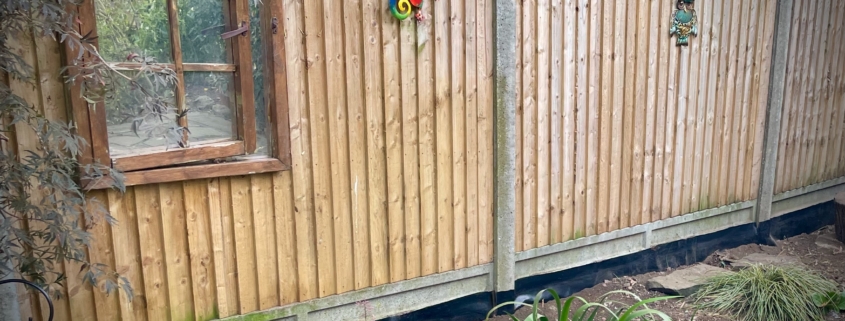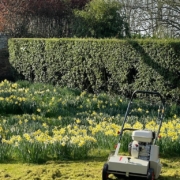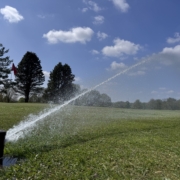Maintaining neighbourly relations with root barrier
Maintaining neighbourly relations with root barrier: Root barriers provide a physical safeguard that can help maintain neighbourly goodwill by curbing the intrusion of bamboo, invasive plant species and unruly tree roots.
A preventative measure, that can be used to contain rampant plant growth and protect property boundaries. With considered selection and installation, root barriers are a defensive measure against encroachment and potential disputes.

Maintaining neighbourly relations with root barrier
Containing & blocking bamboo
Not so long ago, there was what seemed to be an insatiable appetite to use bamboo as a screener. It was frequently planted in UK gardens without consideration for the plant’s non-native status. Years could go by with the plant remaining relatively confined, only for it to suddenly start spreading across lawns and into neighbouring properties.
In the UK climate, running bamboo – the more troublesome variety – can appear like clumping bamboo. The latter remains more confined and spreads slower, whilst running varieties send out bamboo rhizome runners that can be over 3m in length. The associated problems have led to solicitors advertising services for nuisance claims, in much the same way as they’ve been doing for Japanese knotweed.
The installation of bamboo root barrier is a wise precaution when dealing with either a clumping or running variety. There are over a thousand species of bamboo, amongst them some of the fastest growing plants in the world. Bamboo root barrier can be used to prevent bamboo popping up on your own lawn, at client property, or at a neighbouring property.
Tips for using bamboo root barrier:
- Type of Bamboo: Identify whether the bamboo is clumping or running as this impacts the type of root barrier needed.
- Barrier Material: Choose a durable material like high-density polyethylene (HDPE) – HDPE root barrier has the puncture resistance to withstand aggressive rhizomes.
- Installation Depth: A bamboo root barrier depth of at least 60 centimetres deep to effectively contain bamboo rhizomes.
- Above-Ground Extension: Ensure the barrier protrudes approximately 10-15 centimetres above ground to prevent rhizomes from crossing over the top.
- Inspection and Maintenance: Conduct annual inspections and maintenance to trim any rhizomes that attempt to cross the barrier.
- Barrier Coverage: The barrier should form a complete enclosure around the bamboo to ensure containment on all sides.
- Barrier Joining: Use appropriate joining methods such as specialist root barrier tape or root barrier adhesive to ensure gaps do not form between barrier sections.
Preventing the spread of invasive plant species
Japanese knotweed has certainly become the UK’s most notorious invasive plant species. Capable of derailing property sales, causing neighbour disputes, and the subject of highly publicised Japanese knotweed legal cases.
Whilst many now feel comfortable undertaking the installation of bamboo barrier themselves, there are other specific considerations when it comes to Japanese knotweed. Vertical root barrier can be deployed at property boundaries to prevent the plant spreading in from a neighbouring property, or out from an infested one. However, the associated documentation matters.
Japanese knotweed root barrier should be used as one element of a Japanese knotweed Management Plan. An Invasive weed specialist can draw up and implement a plan of this type, which may also include herbicide treatment, or even on-site cell burial of Japanese knotweed using a specialist permeable root barrier. Mortgage lenders and solicitors working for buyers, will expect to see a plan of this type with an insurance backed guarantee. Both are normally required before matters can progress smoothly at a property with knotweed present.
Managing tree roots
Root barrier is not only deployed for aggressive, non-native plants – it’s also frequently used for native species, in the form of trees. In fact, because of the variety of barrier applications for trees, there is a lot of choice when considering the best root barrier for the job.
The requirements of the job need to be carefully considered before an appropriate barrier can be selected and the installation of tree root barrier can commence. Barrier structure and material changes according to the use case:
Planting
Solutions for planting can come preformed hoops or be joined to form a ring. Particularly in urban settings, these products are often specified by landscape architects. Ribbed root barrier is one such variety, designed to steer root growth downward and prevent root spiralling. This mechanism helps plant roots achieve a safe depth, and one at which they won’t interfere with manmade structures.
Redirecting away from utilities and built structures
Root barrier selection for this task is dependent on the structure being protected, the extent of the root area and even the soil in which the tree is present. And, root barrier also has its part to play in protecting utility infrastructures where roots are attracted because of the moisture retained.
Building subsidence
This is another issue, like Japanese knotweed, where specialist expertise is required. Often, in addressing tree related subsidence more advanced root barrier solutions are deployed. For this task, Arboriculturists frequently favour a permeable root barrier, that allows water to pass through.
Measures that maintain neighbourly relations
Many of the benefits of root barrier come from preventing issues before they arise. Legal precedent has set greater consequences to allowing plants to spread, produce damage, or cause the loss of enjoyment of the land. Where there is a risk of such issues, root barrier has a crucial role to play in maintaining neighbourly relations.
If tackling the job yourself, proper preparation is essential, which should include selection of the correct tools for root barrier construction. When confronting intricate issues like subsidence, structural damage, or the containment of regulated invasive species, it is prudent to seek expert guidance.
In situations like these, where root barriers form a part of the remedial strategy, choosing a reputable root barrier installation company is crucial. Before proceeding, examine their track record for installations, the training level of their personnel, and their professional qualifications. It is important to acknowledge that managing invasive species, trees near buildings, and ensuring structural integrity demand distinct expertise and knowledge.
By Jon Barton, MD of root membrane specialists, Root Barrier Store.
For the latest industry news visit landscapingmatters.co.uk/news
Get all of the big headlines, pictures, opinions and videos on stories that matter to you.
Follow us on Twitter and Instagram for fun, fresh and engaging content.
You can also find us on Facebook for more of your must-see news, features, videos and pictures from Landscaping Matters












